Make this easy, melt-in-your-mouth Chashu pork belly recipe at home! Braised in a sweet and savory sauce, these tender slices of meat can now top your next bowl of ramen! It’s the most fulfilling reward for any pork belly lover out there!
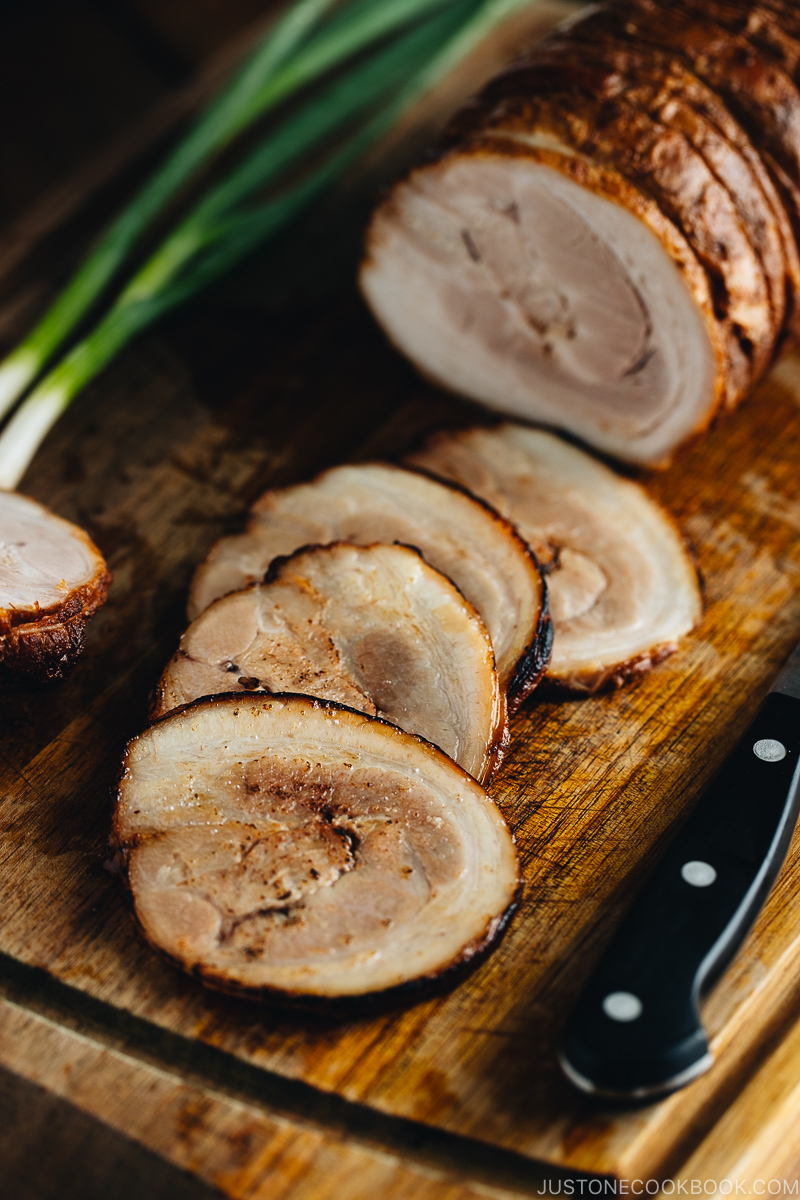
What is your favorite ramen topping? For me, it is the perfectly cooked soft-boiled marinated Ramen Egg (Ajitsuke Tamago). But for most people I know, including Mr. JOC, it is the melt-in-your-mouth juicy, tender, and flavorful slices of braised pork belly known as Chashu (チャーシュー).
What is Chashu?
Japanese have adapted the famous Chinese barbecued pork called Char Siu (叉燒) as chāshū (チャーシュー). Unlike the Chinese version which requires roasting over high heat, we prepare the meat by rolling it into a log and then braising it over low heat in a sauce seasoned with soy sauce, sake, and sugar.
In Japanese, we sometimes call Chashu “Nibuta” (煮豚), literally means simmered/braised pork, as opposed to “Yakibuta” (焼豚), which means barbecued pork. The Japanese enjoy Chashu as a topping for Ramen and other noodles, as well as Chashu over steamed rice called Chashu Don, like a rice bowl.
The Original Chinese Char Siu
Traditionally, Chinese char siu is marinated in soy sauce, honey, hoisin sauce, rice wine, five-spice powder, and red food coloring, and then roasted in a covered oven or barbecued over a fire. You have probably seen the slabs of barbecued pork hanging in Chinese deli shop windows.
Chinese Char Siu offers a good bite with marked, smoky grilled flavor, while Japanese chashu is appreciated for its succulent and fork-tender texture.
Watch How to Make Chashu
Make this easy, melt-in-your-mouth Chashu pork belly recipe at home! Braised in a sweet and savory sauce, you can now add the tender slice of meat as topping to your next bowl of ramen. It’s the most fulfilling reward for any pork belly lover out there!
A Quick Rundown on How to Make Chashu Pork
First, we sear the pork belly over high heat to caramelize the surface of the meat. My go-to choice is a solid cast iron pan which I use for searing meats. With a cast iron, you can really turn up the heat and food comes in direct contact with an evenly heated surface. This step makes a great difference with the finished dish, enhancing it with complex layers of flavors.
After searing the meat, we then braise the meat in a soy sauce based seasoning on a simmering low heat for about 1-2 hours. The pork will slowly soak up all the flavors in the pot. Ginger and long green onion (in Japan it goes by a few names – Naganegi (長ねぎ), Shironegi (白ねぎ) or Tokyo negi (東京ねぎ)) help remove any unsavory smell and add more depth to the sauce.
When the sauce reduces, transfer the meat to a bag or a container with a little bit of sauce, and let marinate in the refrigerator overnight to intensify the flavors.
Next day it’s finally ready to serve. Slice the Chashu thinly but thick enough for the chopsticks to clasp on.

Chashu 2 Ways: Rolled (Log) vs. Non-Rolled (Block)
Chashu served on ramen is often the rolled type, although many ramen shops do serve slices of the Non-Rolled Chashu in Japan. Both ways are legitimate Chashu by the standard of ramen shops, but let’s take a look at the two options.

Rolled Chashu (Log)
The most common preparation for Chashu served on ramen is by rolling a big slab of pork belly into a log with butcher’s twine. The main reason for that is to keep the pork moist. As the meat is not directly exposed to the sauce, meat does not get dry yet it still absorbs flavors.
When I roll the pork belly into a log shape, I usually increase the amount of cooking time because you will need more time to rotate the Chashu and to make sure it soaks up all the good flavors.
You may wonder why I don’t increase the amount of seasoning so that Chashu will be completely submerged. Ramen shops make Chashu every day and they keep re-using the cooking sauce by combining with a new batch of seasoning. To a home cook, it is rather wasteful to make such a big batch of cooking sauce.
That’s why you will need 2 hours to cook Rolled Chashu (as opposed to 1 hour for Non-rolled Chashu).

Non-Rolled Chashu (Block)
If you don’t need a lot of Chashu, consider making Non-Rolled Chashu with smaller blocks of pork belly. The pork belly blocks I buy from the local Japanese supermarket come in small pieces (¾ to 1 lb). Since you don’t need to roll them up into a log, you can start searing the pork belly right away.
The benefit of Non-Rolled Chashu is that braising time takes just 1 hour as the slab of pork belly is fairly flat and easily absorbs flavors. Make sure to use Otoshibuta (drop lid) so that the sauce circulates nicely and won‘t evaporate too much evaporation braising.
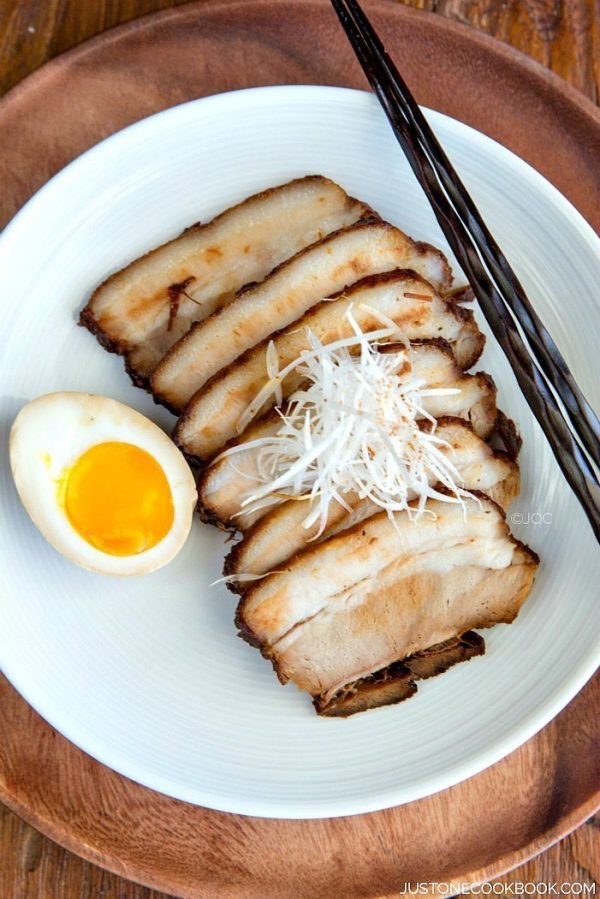
Chashu (Non-Rolled Chashu) served with Shiraga Negi topping and Ramen Egg.
How to Roll and Tie Chashu
Why do we roll Chashu?
- To maintain the shape after rendering fat.
- To keep the moisture in the meat (protected by outer layer/rind).
- To look pretty

Learn how to roll and tie pork belly correctly
You can find the step-by-step pictures in the recipe below and the video above to go over the step, but here’s the quick summary.
- Find out the right orientation for rolling. One or both ends should have the “bacon” like appearance, showing the varying layers of meat and fat.
- Roll up and find how much pork belly you need for a nice cooking Chashu. Cut off any extra meat and save it for other recipes.
- Once you roll up the pork belly into a log, wrap the meat with a butcher twine on one end and make a double knot.
- Wrap 2-3 more times on the same end (the starting point) to make sure it is secured.
- Then run the twine across the log to the far end and wrap 2-3 times tightly. Both ends are now secured.
- From this end, start wrapping tightly and work toward the starting point, keeping ⅓ inches (1 cm) between each wrap.
- Once you reach the starting point, run the twine under some wraps around the middle and then bring back to the starting point.
- Make a double knot with two ends of the butcher twine.
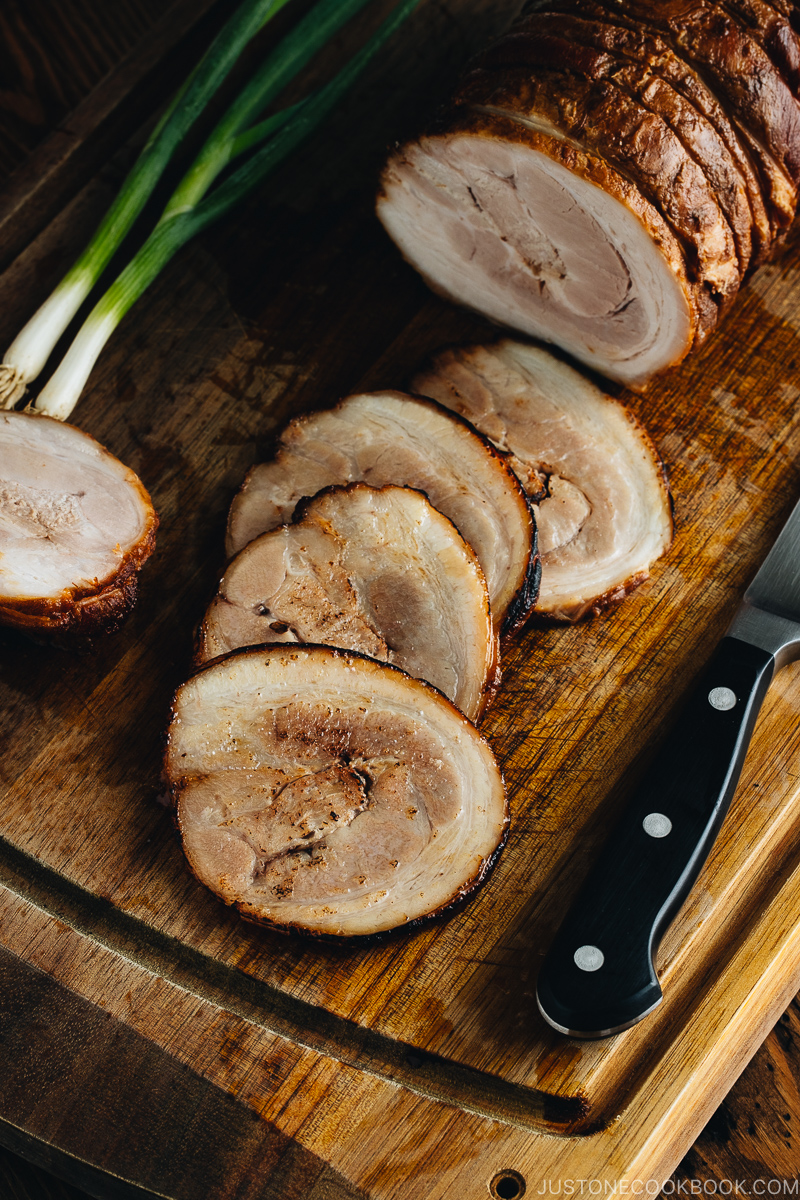
What Cut of Pork Do We Use for Chashu?
The ideal cut for chashu is pork belly, although you can use pork shoulder, and sometimes pork loin. Keep in mind that the last two choices don’t get the melt-in-your-mouth texture as they do not have as much fat as pork belly.
In Japanese cooking, we usually use pork belly without a rind/skin (except for making certain Chinese or Okinawan recipes).
I always use pork belly for my Chashu recipe, but if you try pork shoulder, let me know. I personally would not recommend using pork loin for this recipe.

Where to Buy Pork Belly
You may not find pork belly sitting at the butcher window or sold pre-packaged, but most butchers should have them stored in the freezer. So don’t be shy to ask the butcher at your local grocery stores or meat deli. Ready to make pork belly on the same day? Do call ahead and factor in the defrosting time as they usually come frozen.
The best place to shop for pork belly is Korean grocery stores. They sell different thicknesses and sizes of pork belly. I usually request the butcher to cut a specific size just for me.
You can also ask the butcher to remove the rind/skin (if there is any) or remove it yourself using a sharp knife.

How to Cut Chashu
It’s pretty easy to cut the Chashu into thin slices once it has rested in the refrigerator overnight. A sharp bread knife would make your job relatively easier too.
I don’t usually use up the entire Chashu in one meal, so I’d cut it into several thin slices for Ramen, and then cut the rest into 2 to 3 blocks and pack each piece in the Food Savor bag to store in the freezer. I’ll show you below how I use Chashu besides Ramen.
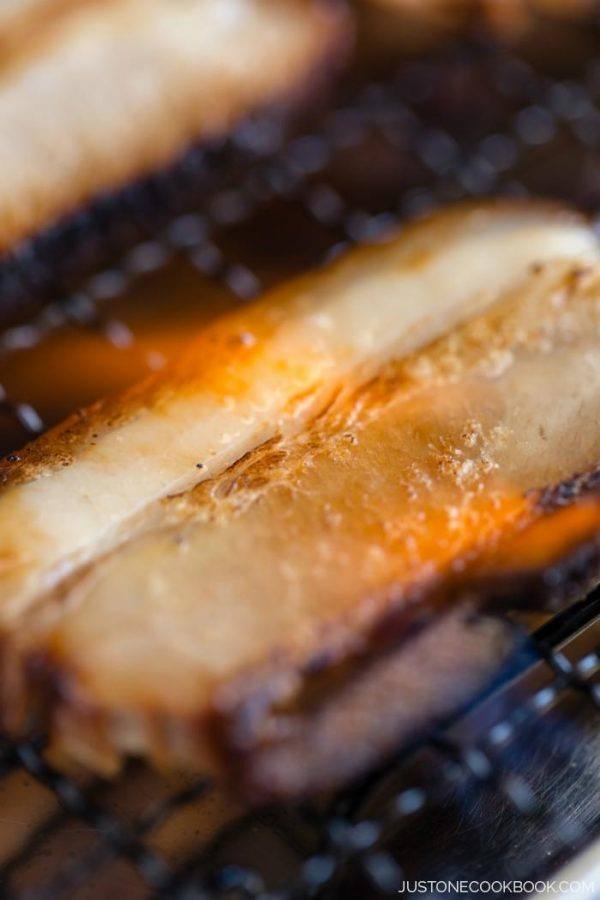
How to Reheat Chashu
There are 3 ways to reheat Chashu:
- Soak Chashu in the hot cooking sauce.
- Directly put in the hot noodle soup.
- Sear the Chashu using a culinary butane torch. We call this Aburi Chashu (炙りチャーシュー). Aburi means searing in Japanese and you may have heard about Aburi Toro and Aburi Salmon from the sushi menu.
I use searing options to reheat Chashu and to add smoky charred flavor. Don’t forget to drizzle some hot cooking liquid on top!
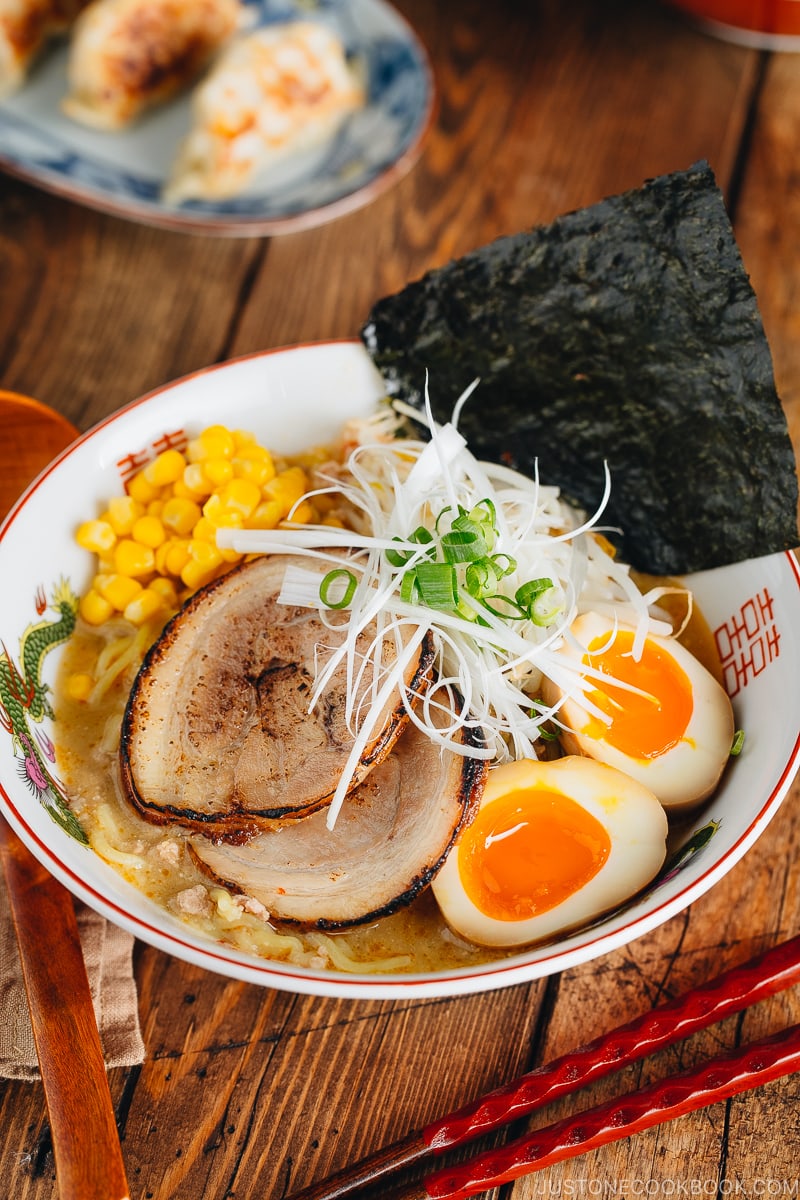
Various Ways to Enjoy Chashu
Besides enjoying Chashu with ramen or by itself, you can also use it for many other dishes. Here are my suggestions:
- Noodle dishes – Hiyashi Chuka and Tsukemen
- Rice dishes – Chashu Don (over rice) and Chashu Fried Rice – a great way to use up the broken pieces or edges of Chashu.
- Sandwiches – Serve with steamed buns (use this recipe)

What to Do with Leftover Chashu Cooking Sauce
- Stir fry seasoning
- Marinate for grilling meat
- Make Ramen Egg

Family’s Favorite Recipe for a Long Time!
I’ve been cooking this exact Chashu recipe for almost 20 years (and on the blog since 2011) and my family loves it. It’s not that difficult to make at all, but you may need to be around in the kitchen while simmering the meat. The final reward is phenomenal and it’s totally worth your time!

Wish to learn more about Japanese cooking? Sign up for our free newsletter to receive cooking tips & recipe updates! And stay in touch with me on Facebook, Pinterest, YouTube, and Instagram.

Chashu (Japanese Braised Pork Belly)
Video
Ingredients
For a Rolled Chashu Log (serves 8–10)
- 1 pork belly block (2–2½ lb, 907–1134 g; roughly 8 x 9 inches, 20 x 23 cm each; remove the rind from your pork belly)
- 1 Tokyo negi (naga negi; long green onion) (green part only; substitute with 1 leek or 2–3 green onions)
- 4 slices ginger
- 1 Tbsp neutral oil (for searing)
- 1 cup sake
- 1 cup soy sauce
- 2 cups water
- ⅔ cup sugar
For a Non-Rolled Chashu Block (serves 3; this is my original recipe posted on May 2011)
- ½ Tbsp neutral oil (for searing)
- ¾ lb pork belly block (for 1 lb (454 g) of meat, see Notes)
- 1 Tokyo negi (naga negi; long green onion) (green part only; substitute with 1 leek or 2–3 green onions)
- 4 slices ginger (from 1-inch, 2.5-cm knob)
- ⅓ cup sake
- ⅓ cup soy sauce
- ⅔ cup water
- 3 Tbsp sugar
Instructions
FOR ROLLED CHASHU (Scroll down for the NON-ROLLED version)
- Before You Start: Please note that this rolled Chashu recipe requires an overnight resting time of 8 hours.
DAY 1
- Gather all the ingredients.

To Prepare the Pork Belly
- Roll up your 1 block of pork belly (2–2½ lb or 907–1134 g). Make sure one or both ends have a “bacon-like“ appearance, showing the varying layers of meat and fat. If your slab comes with the rind, remove it or ask your butcher to do it for you.

- Run some butcher twine under the far end of the log. Tie a double knot to secure the rolled end tightly. Make sure you leave a tail of about 3 inches (7.5 cm) of twine at the end.

- Next, tightly wrap the twine around the spot you just tied another 2 or 3 times to secure the starting point of the roll. Then, pull the twine to the opposite end of the pork belly roll. Tightly wrap the twine around that end 2 to 3 times to secure it.

- Next, start wrapping the twine around the roll back toward the starting point. Space each wrap ⅓ inch (1 cm) apart. Make sure you wrap the roll as tightly as possible.

- Once you reach the starting point, run the twine under some of the end wraps; this hooks the twine in place so you can reverse direction. Next, run the twine under 4 or 5 wraps going away from the starting point. Then, double back toward the starting point, running your twine under the wraps until you reach the original double knot.

- Find the 3-inch tail of twine that you left when you started. Tie a double knot with the tail and the long end of the twine, and cut the excess.

To Cut the Aromatics
- Cut the green part of 1 Tokyo negi (naga negi; long green onion) and set aside; reserve the white part for another use. Cut 4 slices ginger (unpeeled).

To Sear the Pork Belly
- Heat 1 Tbsp neutral oil in a cast-iron skillet (or regular frying pan) over high heat. Add the tied pork belly to the skillet.

- Sear the pork belly one side at a time, rotating it to make sure all sides are golden brown.

- It’ll take about 10–15 minutes all together.

To Prepare the Braising Liquid
- While the pork is searing, prepare the braising liquid. Put 1 cup sake, 1 cup soy sauce, 2 cups water, and ⅔ cup sugar in a heavy-bottomed pot (I used a Dutch oven) that will fit the chashu. Then, add the Tokyo negi (green part) and 4 slices ginger.

To Simmer the Chashu
- Transfer the seared chashu roll to the Dutch oven.

- Bring the liquid to a boil over medium heat.

- Once boiling, skim off the foam and scum. Then turn the heat to low/simmer.

- Put an otoshibuta (drop lid) on top to press the ingredients down and limit the evaporation. You do not need to use a regular lid to control the evaporation. If you don’t have an otoshibuta, you can make one with aluminum foil (here’s how to make the otoshibuta).

- Simmer on low heat, and cover with the otoshibuta at all times for the next 2 hours, turning the chashu every 30 minutes.

- After 2 hours, the braising liquid has reduced a bit. Turn off the heat to let the chashu roll cool a little bit.

To Rest the Chashu Overnight
- Once the meat is slightly cooled, transfer it to a container or a plastic food vacuum-sealing bag, such as one for the FoodSaver system. (If you‘re doubling or tripling this recipe, put each chashu roll in its own bag.) Strain the leftover cooking liquid through a fine-mesh strainer.

- Add ½ cup of the cooking liquid into the bag. If using a container, add about 1 inch (2.5 cm) of the braising liquid to the bottom and cover.

- If using the FoodSaver bag, seal it with a FoodSaver sealer. Tip: Fold a piece of paper towel to plug the entry of the FoodSaver bag. This paper towel will absorb any extra moisture when you seal.

- Tip: I also made quick Ramen Eggs (Ajitsuke Tamago) with the leftover liquid. Simply cook and peel soft-boiled eggs, add them to a bag with ½ cup of the cooking liquid, and close. Cover the cooking liquid, and store the chashu, ramen eggs, and the cooking liquid in the refrigerator.

DAY 2
- Open the bag of chashu.

- Cut the twine with kitchen shears and remove the twine pieces completely.

- Slice the chashu into ¼-inch pieces and keep the end piece for Chashu Fried Rice!

- Place the chashu slices on a ceramic plate. Sear and enhance the flavor with a kitchen butane torch. You can also use a broiler in the oven. Enjoy them immediately or serve on your ramen.

- Scoop up and discard the solidified fat from the cooking sauce.

- Strain the sauce over a fine-mesh sieve to make sure the solidified fat is left behind. Pour the sauce into a mason jar or container and seal. The sauce will last for a month in the refrigerator. I use it for drizzling over the chashu and for making stir-fried dishes, marinades, and ramen eggs.

To Store
- You can store the chashu in the refrigerator for up to 7 days or 1 month in the freezer. I usually divide the rolled chashu into thirds and freeze 2 portions separately (for ramen right away, and Chashu Fried Rice and Chashu Bowl for later). Ramen Eggs should be consumed in 3–4 days if they are soft-boiled eggs and 7 days if hard-boiled eggs. The eggs get saltier the longer you keep them in the marinade, so remove them from the sauce when they have the right taste.
FOR NON-ROLLED CHASHU
- Gather all the ingredients. For small blocks of pork belly (about 1 lb) like I‘ve used here, you don’t need to roll them up before cooking, and the simmering time is just 1 hour (instead of 2 hours). Tip: To cook 1 lb (454 g) of pork belly, see the ingredients list in the Notes section at the end of the recipe card.

- Heat a cast iron skillet (or regular frying pan) over high heat. When the pan is hot, add ½ Tbsp neutral oil. Sear ¾ lb pork belly block fat-side down first, then flip over to sear the other side; this will take about 10 minutes.

- While searing, prepare a heavy-bottomed pot (or regular pot) that will fit the chashu. To the pot, add the green part of 1 Tokyo negi (naga negi; long green onion), 4 slices ginger (unpeeled), ⅓ cup sake, ⅓ cup soy sauce, ⅔ cup water, and 3 Tbsp sugar. Once you‘re done searing the meat, add it to the pot. Bring the liquid to a boil, skimming the scum and foam. Then, turn the heat to low/simmer.

- Put an otoshibuta (drop lid) on top to press the ingredients down and limit the evaporation. If you don’t have an otoshibuta, you can make one with aluminum foil (here’s how to make otoshibuta). Simmer on low heat for 1 hour, turning the chashu every 15 minutes and keeping an otoshibuta on at all times.

- After 1 hour, there is ½ inch of liquid left in the pot. Now, you have 2 options. Option 1: If you’re serving it right away, remove the otoshibuta and further reduce the sauce on low heat until the sauce thickens and you can see the bottom of the pot when you draw a line through the sauce with a spatula. Option 2 (recommended): Transfer the chashu to a container or bag with a little bit of cooking sauce and refrigerate overnight. Strain the leftover cooking sauce, transfer to a jar, and refrigerate.

- To serve, slice the chashu into ¼-inch (6 mm) pieces. Sear and enhance the flavor with a kitchen butane torch. If you stored the chashu overnight and don’t want to sear the chashu, you can reheat it by soaking it in hot cooking sauce.

Notes
- 1 lb pork belly block (454 g)
- 1 negi (long green onion) (substitute with 1 leek or 2-3 green onions)
- 1 knob ginger
- ½ Tbsp neutral-flavored oil (vegetable, canola, etc.)
- ½ cup sake (120 ml)
- ½ cup soy sauce (120 ml)
- 1 cup water (240 ml)
- ⅓ cup sugar (75 g, 5 Tbsp)
Nutrition
Editor’s Notes: This post was originally shared in May 2011. The first video was added in September 2014 with new images. New video and images are added in May 2019.





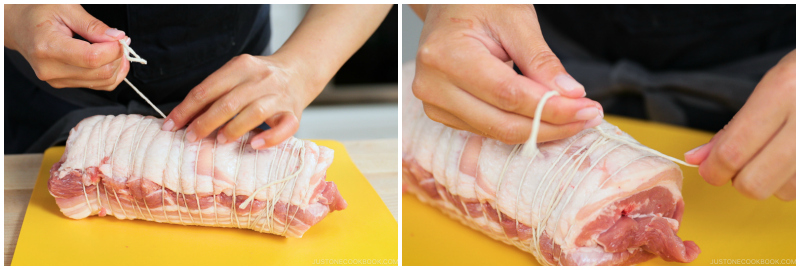








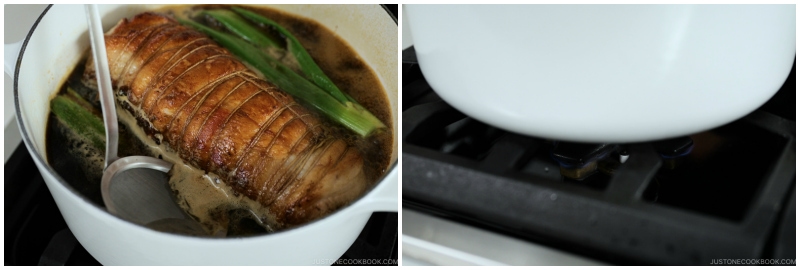


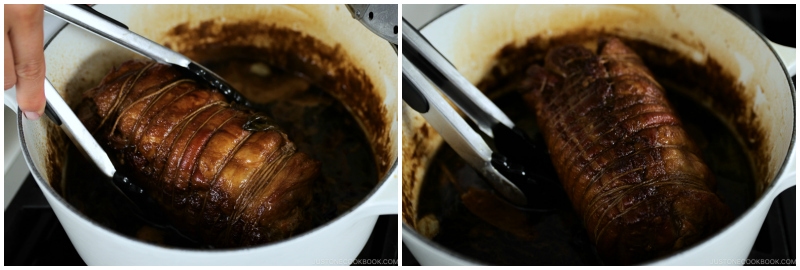













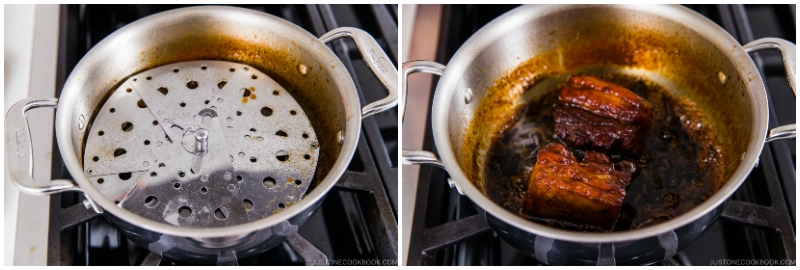
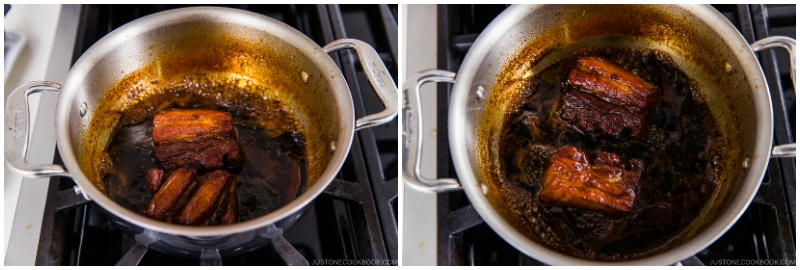
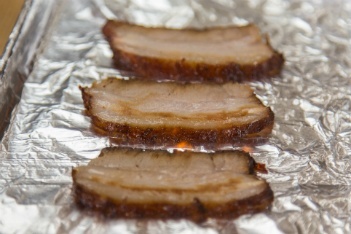












been using this recipe for level up my instant ramen! thanks for this recipe…I wasn’t able to replicate it exactly but the overall result was still really great! I used pork chop and just followed the non-rolled instructions although sometimes the sauce gets dried up/evaporated all so I had to lower the cook time or add more water..the end result was still super delicious, great for adding to instant ramen!
Hi bibbo! We love your Chashu ramen photo!🤩
Thank you very much for trying Nami’s recipe and sharing your cooking experience with us.
Next time, please try lowering the heat a bit. You might not need to change the cooking time or add water.
We hope this helps!
OK, don’t hate me for making major changes (pressure cooking etc.) but I loved this.
My H Mart had beautiful, skin-on, meaty pork belly but only in long, 1.5 inch wide strips, so that is what I had to work with. I cut each long strip into 3-4 pieces and used your flat/unrolled recipe amounts of water, soy, sake, etc. My time was limited today due to a sudden change of plans and I pressure cooked all of this on high (stovetop PC) for about 32 minutes (I checked after 20 minutes and then added 5, and then 7 to finish) – melting texture (including soft, unctuous skin) and delicious flavor. It looks dark but does not taste too dark or too salty. I’m keeping all braising liquid to store the cooked chunks, and also to see if a spoonful is a good way to finish stir fried veg tomorrow. Delicious!
Hi Marla! Awesome!🤩 Thank you very much for trying Nami’s recipe and for sharing your cooking experience with us!🙂
This looks AMAZING.. Will definitely make with my Ramen later this week…
Hi Matthew! Thank you very much for reading Nami’s post and trying her recipe!
We hope you enjoy Chashu and Ramen!
Just made this recipe with the non-rolled version. Never realized how easy it is to make Japanese chasu. My only mistake was that I let the liquid cook down too much so there wasnt enough left for when I need the chasu warmed up. I ended up slicing the pork and soaking it into the remaining sauce. I may also make some more liquid (just a tiny amount) for when I need to warm up the chasu just because I love that extra flavor on all sides of the pork. It’s gonna be so good in a nice bowl of ramen or even chopped up over rice. Thank you so much for the recipe!
Hi Mia! Thank you very much for trying Nami’s recipe and sharing your cooking experience with us!
We are so happy to hear you enjoyed homemade Chashu! Happy Cooking!
Hi Nami!
I am going to try making this delicious chashu. Have you tried cooking it in a pressure cooker so cut the cooking time? Can you share the cooking method if you have? Thanks!!
Hi Shirley, Thank you very much for trying Nami’s recipe!
Nami had tried with the Instant Pot before. She didn’t like that you need more amount of each condiment to cook in the Instant Pot because you can’t keep rotating the meat. If you are making a lot of Chashu in one pot, you probably feel okay using that much condiment.
She has a similar pork belly recipe using the pressure cooker here. We hope you can reference the pressure cooker cooking method from this recipe.🙂
https://www.justonecookbook.com/pressure-cooker-pork-belly-kakuni/
I was unable to get a pork belly block to make this (that’s what I get for trying to find some at 8pm on a sunday!) but I was able to find some pork steaks that had similar marbling. After layering the two steaks and making a grand attempt to roll them I ended up with a very similar looking log of meat. Everything after that went according to plan and it was oh so tender and delicious!! Thank you so much for this wonderfully written recipe which allowed me to make something very similar even without having the right cut of meat! Your recipes have never failed me and keep me coming back. Thanks again:)
Hi Rebecca! Awesome! We are so happy to hear it worked very well for you and you enjoyed it!
Thank you very much for trying Nami’s recipe and sharing your cooking experience with us! Happy Cooking!
Hi Nami, is it a must to remove skin? Can the non rolled be cooked with skin on?
Hi Nany, You can cook skin-on meat if you prefer. We recommend searing the skin side well. Thank you for trying Nami’s recipe!
Another question-what is the size of your otoshibuta? What size do you recommend for a 5 quart Dutch oven and a 26-28 wok?
Hi Nany! The Otoshibuta size should be slightly smaller than the diameter of the pot/pan.
Here is the post where Nami explains more about Otoshibuta.
https://www.justonecookbook.com/how-to-make-otoshi-buta/
We hope this is helpful.
Thank you Naomi. Yes, I’ve read that post already. I just don’t really know the sizes in inches so wanted, for reference and comparison, to know the size of Nami’s otoshibuta. Thank you Naomi for your kind reply.
Hi Nany, 1 inch is 2.54 cm. Nami uses an expandable stainless steel lid to fit in different sizes of pots and pans, as she showed in the post.🙂
https://www.amazon.com/dp/B001DDUZB2?ref=exp_justonecookbook_dp_vv_d
We hope this helps!
Hi dear Nami 🙂
I’m drooling….amazing amazing recipe. I must make your chashu. A question, after reducing the sauce, isn’t it too salty? And how do you use he leftover sauce to make a soup? Thank you for your amazing recipes.
Hi Nany! Thank you very much for reading Nami’s post!
The sauce will be sweet and savory. Nami recommends using it for drizzling over the Chashu and making stir-fries, marinade, and ramen eggs.
If you are interested in making a soup with the sauce, you probably need to dilute it with some Dashi. We hope this helps!
Phenomenal recipe. I’ve made it now 3x during Covid and my family (also Japanese and also based in San Mateo) and friends love it. Ive added a few katsushiaji – fish sauce and brown sugar.
Hi Mateo! Aww. Nami and JOC team are so happy to hear your family enjoyed the homemade Chashu!
Thank you very much for trying this recipe and sharing your cooking tips with us.
Hello Nami! I’m a big fan of your site and finally decided to try this chashu, and it turned out pretty well! However, somehow the crust/skin from frying it the initial 10 minutes fell partially off during the simmer. I made a rolled porkbelly, with the fat layer on the outside. Maybe I was turning it not carefully enough..did you ever had that? Any idea what could be the issue?
Secondly, I didn’t have a droplid, so I used aluminium foil..however, this is not heavy enough to push down a 1.2kg piece of meat, so the meat was just approx. 2/3rd submerged in the liquid. Is that problem?
Ah and also: Is there any particular reason you haven’t used the dutch oven for browning the meat but a cast-iron skillet? I’m still never sure which pan I should take for what purpose so I’m curious if there is any reason behind it 🙂
Hi Kevin! Nami has a couple of reasons (just her preference)
1) Nami does not want to add excess oil from searing the Chashu to the Sauce mixture, so pick up the seared rolled Chashu and leaving extra fat/oil in the cast iron pan. It will also save some time washing the pot during the cooking process. If you use a dutch oven for searing the rolled Chashu, take out the Chashu, and wipe off the oil with paper towels or discard the oil and rinse before adding the sauce ingredients.
2) Nami can use higher heat with a cast iron pan than a Dutch oven, and it’s easy to clean a burnt cast iron pan than the Dutch oven.
We hope this helps!🙂
Hi Kevin, Thank you very much for trying Nami’s recipe!
Did you wrap the twine a ⅓ inch (1 cm) in between them? And make sure to turn the meat carefully and cook over low heat.
The Otoshibuta doesn’t need to be heavy to push down the meat. It is to cover the meat so that the handmade aluminum foil with holes will be just fine. The liquid amount sounds good (submerged 2/3rd of meat), but if your meat is 1.2 kg, you can use the ingredient amount for 9 servings instead of 8 servings. We hope this helps and your next try will be successful!
Nice recipe, Nami-chan!
I love garlic, so I sliced a bulb in half and added to the liquid ingredients, and also added 1 cup of mirin and used 3 naganegi instead of one.
Keep up the good recipes!
Hi Steve! Thank you very much for your kind words to Nami and for sharing your cooking experience with us!
Happy Cooking!
I’ve bought Yakibuta/chashuu pork from my local Japanese store. Its house-made and is already frozen. It’s looks like it’s been seared and tied already and has a hint of shoyuu . What are the chances that the owners already marinated this in seasoning? The store is closed and I’m not able to ask.
Hi Chris, We are not sure if the meat had been cooked and marinated or not without seeing or smelling it.
Maybe you can reheat/defrost first and cut the tiny slice, then cook the portion on the pan and taste it? We hope this helps.🙂
Hi, Nami!
Can I do the braising part in my Instant Pot
Hi Ana, We haven’t tried the part in Instant pot, but we think you can do that. Let us know how it goes!
Hi Nami-san!
I tried your recipe and it turn out very nice! my family loved the tenderness of the rolled chashu! The process is so simple and easy to follow. May I check with you, if I want to make more rolled chashu, do I need to double the sauce volume or can I just add additional piece of the rolled meat into the pot (if there is sufficient space)?
Hi Dawn, We are glad to hear you and your family enjoyed Chashu! Yes, you may add more rolled Chashu in the pot. When you rest Chashu overnight, make sure to add extra liquid for the extra piece. We hope this helps!